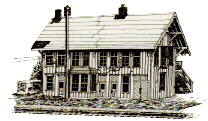 |
CRAWFORD COUNTY HISTORICAL SOCIETY |
|---|---|
Preserving the heritage and artifacts of Crawford County
| |
A Video Tour of our Museum Rooms
DEPOT (LOBBY)
Welcome to our Museum Tour! You will be taken through the Depot to get a glimpse of Crawford County history. Enjoy a view of railroad, river and lumbering life from days long past.In 1872, the Jackson, Lansing & Saginaw Railroad Company (JL&S) laid track to Grayling. JL&S built a freight house and named the area Crawford Station. In 1882, JL&S leased the rail stop to Michigan Central Railroad (MCRR) which built the two-story Depot that now stands. MCRR also built a roundhouse at the present site of the County courthouse. There were eight tracks between the Depot and roundhouse. Seven northbound passenger trains and five southbound trains as well as freight trains went through Grayling daily. The tour begins with entering the Lobby - the only part of the Depot which was open to the public. The telephone to the left of the door was made in 1900. There is one exactly like it upstairs. The phones work and they are a great source of fun. A volunteer in the Lobby will hear the phone ring and when he answers it, many times there is no response. The visitor upstairs is shocked to hear a voice on the other end. The bookcase holds various items from barbershops during the turn of the century. The original ticket window and counter are still intact. Next is the Au Sable River display. In the mid 1800s, men from Europe, Scandinavia and Australia were drawn to the cold, clear waters of the River which made the grayling so plentiful (after which the city is named). A section is devoted to men who built riverboats and were guides - Arthur E. Wakeley, Jay Stephan Sr., Ralph Redhead and Earl Madsen, to name a few. Handmade tools used to make riverboats rest on the bookcase. The hallway is dedicated to the Au Sable River Canoe Marathon which began in 1947 and is now an international event which takes place every July. The race begins in Grayling and ends in Oscoda as the racers follow the course of the River. There are photos of past races and winners, a complete list of winners' names and dates, memorabilia including the 1948 wooden paddle used by Ted Engle, and four limited-edition prints by artist Terry Dickinson. The cases reveal the uses of the River from the early days of the Native Americans to its present day use of fishing and canoeing. Above one of the cases is a picture of the vibrant waters of the Au Sable taken by photographer Rob Bonkowski. Above that are maple canoe paddles made by Chief Shoppenagon, a famous river guide. Suspended from the ceiling is a 24 foot long riverboat made by Arthur E. Wakeley in 1915. The boat is made of five cedar planks and has a live fish well. The riverboat is used only on the Au Sable. Because of its straight sides and flat bottom, this boat rides high in the sandy, shallow waters and is extremely stable. The white side door was not originally part of the building but now opens to the courtyard which holds the Military Annex, firehall, barn, log cabin and caboose. A mother and son wait for the train to arrive - an example of passengers filling the Lobby, a reminder of days long past when the Depot bustled with activity and when one could feel anticipation in the air as all waited to see the steam engine pull the train into the station. |
|---|